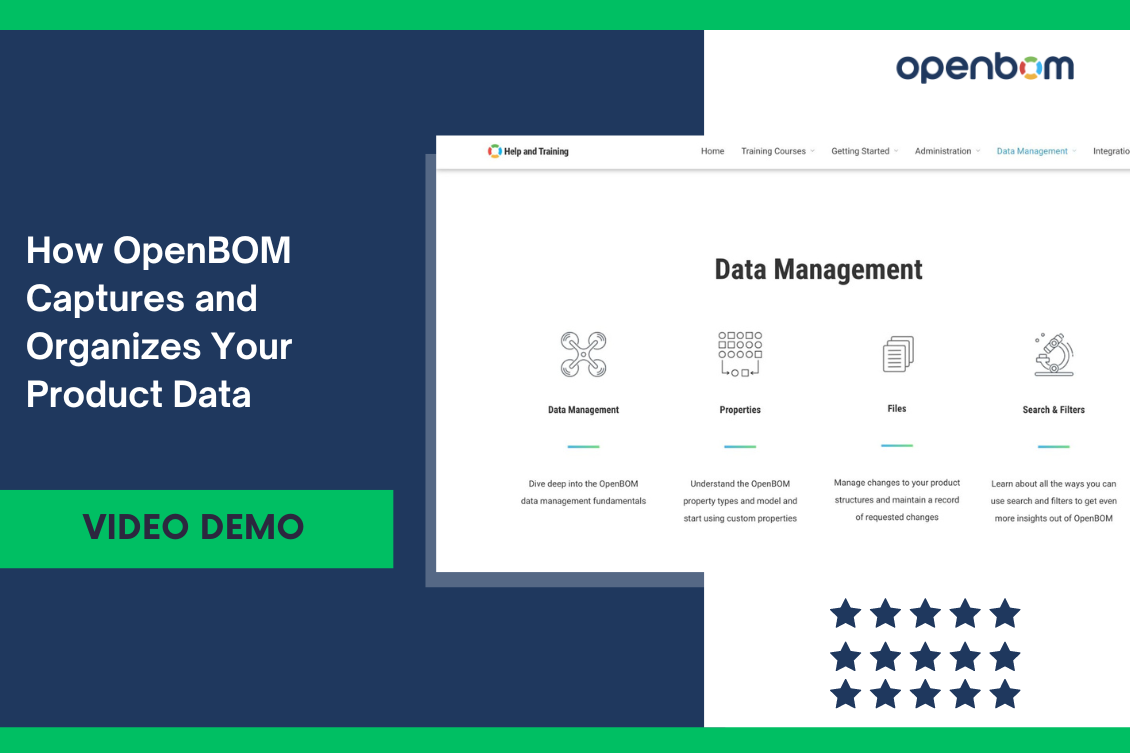
In a modern manufacturing and product development environment, speed and innovation are two fundamental elements of success. However, the complexity of managing product data has become more challenging than ever. Companies are dealing with an increasing volume of information, spanning various formats, departments, and stages of the product life cycle.
Moving away from disparate files and folders to a more connected and organized approach is no longer a luxury—it’s a necessity. As the need to control and access accurate, up-to-date data grows, the importance of adopting a robust data management system becomes clear.
OpenBOM is designed to meet these challenges, offering a comprehensive solution that captures, organizes, and connects your product data like never before. In my article today, we share the main principles of OpenBOM data management and show you a video with OpenBOM data management examples.
Data Trust: Ensuring You Have the Right Information
One of the greatest challenges companies face is ensuring that they are working with the correct data. Outdated spreadsheets, lost files, or incomplete information can lead to costly mistakes and delays. OpenBOM addresses this issue by providing a single source of truth, accessible through a simple, flexible, and connected user experience. With OpenBOM, you can trust that the data you are viewing is accurate, up-to-date, and complete, giving you confidence in every decision you make.
Objects and Files: A Flexible Data Model
At the heart of OpenBOM’s powerful capabilities is its flexible data model. This model is built around objects, attributes, and connected resources, such as links or files. OpenBOM allows you to visualize, customize, and edit this data seamlessly. Whether you’re dealing with a complex Bill of Materials (BOM) or managing various product attributes, OpenBOM’s intuitive interface makes it easy to organize and manipulate your data, ensuring that everything is where you need it when you need it.
Changes and Revision Control: Seamless Tracking and Management
Managing changes and revisions is a critical aspect of product data management. OpenBOM provides a seamless mechanism to track changes and manage revisions for both data and file elements. Whether it’s a minor update or a major revision, OpenBOM ensures that every change is recorded and traceable, giving you complete visibility into the history and evolution of your product data.
Data Sharing: Simplified and Secure
In today’s collaborative work environment, sharing data is essential. OpenBOM makes data sharing as easy as any modern data management application, such as Google Docs. Its multi-tenant data model allows you to share information across multiple teams, companies, and different accounts, all while maintaining control over who has access to what. This flexibility ensures that everyone involved in the product lifecycle—from engineers to manufacturing planners to sales and procurement—has the information they need when they need it.
Integration with Engineering Apps: Seamless CAD Connectivity
A key feature of OpenBOM is its seamless integration with all major CAD systems. This connectivity ensures that your engineering data flows effortlessly into OpenBOM, allowing you to maintain a single source of truth across all your design and manufacturing processes. This integration not only saves time but also reduces the risk of errors, ensuring that your data remains consistent and reliable throughout the product development lifecycle.
Role-Based Data Access: Tailored Information for Every Role
Different roles within your organization require access to different slices of data. OpenBOM’s flexible data organization allows you to provide the right information to the right people at the right time. Whether it’s engineers needing detailed design data, manufacturing planners looking for production information, or procurement teams managing supplier relationships, OpenBOM ensures that each role has access to the specific data they need to do their job effectively. The foundation of this role-based tailoring uses product lifecycle digital twin including xBOM service and custom data modeling.
Demo Video
Watch the demo of all elements of the OpenBOM data model in the video below.
Conclusion: Experience the Flexibility and Ease of OpenBOM
The flexibility and ease of use that OpenBOM offers are two of its most significant advantages. By moving away from fragmented and outdated data management practices, OpenBOM enables you to capture, organize, and share your product data more effectively than ever before. Ready to see for yourself? OpenBOM’s free registration and instant trial provide the perfect opportunity to experience the power of connected product data management. Start your journey with OpenBOM today and discover how it can transform your product development processes.Best regards,
Oleg Shilovitsky
Join our newsletter to receive a weekly portion of news, articles, and tips about OpenBOM and our community.










